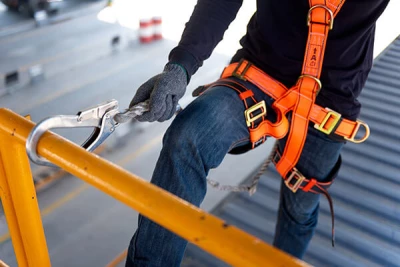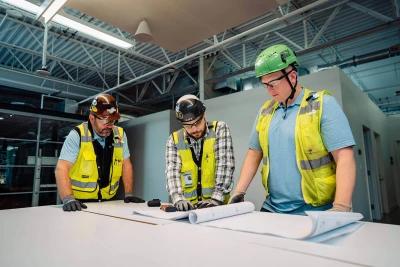Electrical Safety
Published 8.1.2022
The hazards associated with electricity affect most of our workplaces. Whether you work in the field, the warehouse or even in the office - electrical hazards are present. It is important to be able to recognize the electrical hazards around you and know how to mitigate them.
According to the Bureau of Labor Statistics, there were 126 fatalities and a total of 2,220 injuries that required days away from work in 2020 due to contact with electricity. It should also be no surprise that the construction industry experiences the vast majority of injuries and fatalities due to contact with live electrical circuits. These statistics do not include injuries caused by secondary events. For example, an individual falling from a ladder due to getting shocked. If these types of injuries were included the statistics would be much higher.
What are some of the common electrical hazards we encounter daily?
- Overhead power lines
- Underground power lines
- Lightning
- Faulty equipment
- Working on or around energized equipment
- Improper grounding
- Exposed or uncapped electrical wires
What can you do to mitigate electrical hazards to a safe level?
- Maintain at least a 10-foot distance from 50 kV overhead power lines, add more distance as the voltage increases. Also, avoid the poles themselves to avoid bringing lines to the ground.
- Inspect all cords for damaged insulation or missing ground prongs. If either of these conditions exists, cut them up and replace them with serviceable cords.
- Never work on energized equipment. Always follow proper lock and tag out procedures before performing electrical work. Test the power after locking and tagging out to ensure there is no power being fed to what you are working on.
- Do not operate electrical equipment in wet conditions. Also, avoid having electrical components in a wet environment unless they are protected.
Remember This!
There are many different electrical hazards in any workplace. It is important to understand electrical safety and respect the dangers electricity poses. Eliminate any electrical hazards in your work area to avoid an injury to yourself or another coworker.
Severity & Frequency
Published 8.8.2022
When evaluating hazards of a new job or task, many people evaluate severity versus frequency. Using this method enables us to compare a less severe but more frequent outcome to a severe but less frequently occurring outcome to decide where to place the most time,
energy, and resources in mitigating hazards to prevent incidents.
Ask yourself - What am I doing today? How could I hurt myself while doing it? What is the worst thing that can happen and how likely is it to happen?
Defining Severity
Severity is defined as “the fact or condition of being severe”. Severe is then defined as “of something bad or undesirable; intense”. We are all familiar with terms such as severe storm or severe consequences, but severe can mean different things to different people. When evaluating outcomes of an incident occurring it is useful to use a scale from 1 to 10 or 1 to 100 and assign examples to the numbers to help define severity. For example, a person who is evaluating the negative outcomes created by a hazard of a new work task may feel that an incident that results in a recordable injury is a 7 on a 1 to 10 scale. A 10 on the scale may be a fatality or losing an entire building to a fire. This creates more of a solid definition of what is considered severe to the individual, group, or company evaluating the hazards and negative outcomes of a new work task.
Defining Frequency
Frequency is defined as “the rate at which something occurs or is repeated over a particular period
of time or in a given sample”. The term frequent, just like severe, can also mean many different
things to different people. The same method of assigning numbers to severity can be done for
frequency to better define it. After defining frequency, you can look at both severity and
frequency of negative outcomes resulting from the different hazards of a new work task or a
possible negative event.
Why Both Severity and Frequency Need to be Evaluated
It is not enough to just focus on the hazards or events that have the most severe outcomes. If the
frequency of the event causing the severe outcome is very low, then it may not be what needs the
most attention. A hazard or event that occurs very frequently and causes a low severity incident
may need more attention to protect employees.
Remember This!
Often times it is the smaller, more common hazards that lead to the majority of workplace injuries, not the hazards that cause the most severe outcomes.
Stroke Symptoms: From F.A.S.T. to F.A.S.T.E.R.
Published 8.22.2022
Strokes, just like heart attacks, are serious medical emergencies that occur all too often. They are the leading cause of serious long-term disability and are the third leading cause of death in the United States. Each year over 795,000 people experience a stroke in the US.
The acronym FAST (Facial drooping, Arm weakness, Speech difficulties and Time) has been used by the National Stroke Association, American Heart Association, and others to educate the public on detecting symptoms of a stroke. However, there is an updated acronym – FASTER – which adds two additional, but key, stroke symptom indicators.
F – Face, refers to drooping or numbness on one side of the face versus the other. Ask the person to smile to make the droop more apparent.
A – Arms, refers to one arm being weaker or numb as compared to the other. Ask the person to raise both arms up and hold them for a count of 10. If one arm falls or begins to drop, this could be a sign of a stroke.
S – Stability, refers to steadiness on your feet. Sometimes individuals will fall, feel very dizzy or be unable to stand without assistance. Difficulty maintaining balance, trouble walking, and loss of coordination are all possible stroke symptoms.
T – Talking, refers to changes in speech including slurring, garbled, nonsensical words, or the inability to respond appropriately. Individuals experiencing a stroke may be difficult to understand, or they may have difficulty understanding others. Ask the person to repeat a simple sentence like “The sky is blue.”
E – Eyes, refers to visual changes. These visual changes occur suddenly and can include complete vision loss in one eye, double vision, and partial loss of vision in one or both eyes.
R – React, which is a reminder to call 911 immediately if you recognize any of these symptoms. Call even if the symptoms go away and try to remember when they first began.
If an individual is showing any of these symptoms and you suspect they may be suffering from a stroke, prompt medical attention is crucial to minimizing the effects the stroke can have or prevent death. Some of the treatments for victims must begin within a few hours and if they do not then the victim can face debilitating injuries if they survive. Just like any other type of medical emergency, never hesitate to call 911. It is always better to err on the side of caution when dealing with something as serious as a stroke.
Remember This!
Because of the sheer number of strokes each year, there is a good chance someone you know could experience one. Knowing what to look for when dealing with someone who is having a stroke is critical. You can be the difference in whether a victim gets the care they need quickly.
Noise at Work & Home
Our hearing is precious to us. Once we diminish or lose our hearing, we can never fully recover it. Both on the job and at home there are many ways to be overexposed to sounds that can damage our hearing. It is important to realize how loud is too loud and how to protect ourselves.
Noise at Work
Many tools, equipment, and processes in the workplace generate high levels of noise that will have a negative effect on your hearing. Occupational hearing loss is one of the most common workplace injuries in the United States today.
Damage to our hearing can happen over a short time or over a longer extended period of time depending on the source of the sound. Short loud bursts of noise such as explosions or gunshots can damage our ears in a short time of being exposed. Less hazardous noise such as woodworking equipment, heavy equipment, and machinery can lead to damage over an extended amount of time being exposed to the noise.
Noise at Home
While many people are overexposed at work, there are also many who are overexposed at home. Many of our hobbies may also be causing hearing loss. Activities such as listening to loud music, shooting guns, woodworking, using a lawnmower, riding a dirt bike, etc. will damage your hearing over time. It is important to understand what levels of noise will damage your hearing.
Hearing Damage Prevention
• The best way to protect yourself is to eliminate the exposure. This can be achieved by removing yourself from the area the noise is in or eliminating the excessive noise altogether.
• Engineering controls - are the second-best choice in protection from noise. Sound barriers, enclosures, and noise dampening systems are examples of engineering controls that will bring down the level of noise in an area.
• Administrative controls - such as training on using hearing protection, job rotation, breaks, and routine maintenance programs of equipment are some ways that protect you from being exposed to hazardous noise.
• PPE – this is the last line of defense. It is important to know the levels of noise that remain after applying the other protective measures mentioned above. For noises between 85 decibels on an 8-hour TWA, ear plugs will be enough to protect you if worn correctly. Over 100 decibels then double hearing protection is needed, an example is earplugs and earmuffs.





